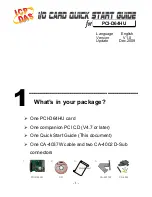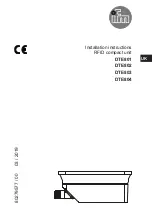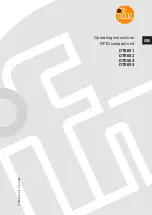
Notes
**If the DALI cables are overloaded for a long period or short-circuited the DALI interface switches to “high impedance” until
the fault is eliminated. The ON LED goes out and the fault LED lights up. The fault contact is not closed in this case.
The DALI interface should be treated in the same way as mains voltage.
DALI interface on the controller
The DALI interface on the controller supplies the DALI interfaces of the connected DALI components. To ensure that the
maximum summation current of 250 mA permitted for DALI is not exceeded no other DALI supplies or DALI controllers may
be connected in this system. To ensure that the maximum permissible voltage drop on the interface cables of 2V in accor-
dance with the DALI specification is not exceeded the cable cross-section must be selected in accordance with the table in
the technical data.
Notes:
1. Only appropriate DALI components may be connected to the DALI interface of the controller.
2. Exposure of the DALI interface of the controller to mains voltage may lead to damage or destruction of the controller.
3. The controller must not be combined with a mains voltage operated 1-switch controller (=Touch Dim).
Mains failure/DALI failure
If the power supply to the controller fails the connected DALI units, which are still being supplied with power, are switched to
maximum brightness (see also information supplied by the manufacturers). When power returns to the controller it automat-
ically restores the lighting system to its status prior to the failure.
Replacing/expanding units
If DALI ECGs or DALI converters are added, make sure that the maximum number of 64 units is not exceeded. Newly added
units should be incorporated in the system as described in “Group assignment”, already existing units should be confirmed
with the master button.
If units are removed, also the “Group assignment” has to pass and the existing units should be confirmed with the master
button (see also “Group assignment”).
Control buttons
Normal commercially available buttons (make contacts with basic insulation) can be used. Between 1 and five buttons are
needed depending on the application. The central button is needed for the construction site sum function; buttons T1 and T2
are also needed for starting the system and for group assignment (they need to be close together as they have to be operat-
ed together).
If more than the first two groups and/or scenes are used, buttons T3 and T4 will be needed. Buttons may be connected in
parallel to operate the lighting system from different places. Functions can be separated by installing buttons in different
areas. The master button always acts on the entire system.
If all five buttons are to be provided at one location a rocker switch may be used for the master sum function, for example,
and a 4-way rocker switch for T1 to T4.
Cable routes:
The relevant wiring requirements governing cable routes, insulation, fusing and
minimum cross-sections must be observed.
Design:
Insulation casing Snap-on mounting for rails, for surface mounting and installa-
tion in distributor
Dimensions:
WxHxD=140x90x61mm (8TE)
Weight:
approx. 550g
Labelling:
CE
Terminal assignment:
see wiring diagrams and information printed on unit
If incorrectly connected there is a risk of failure, malfunction or destruction



































